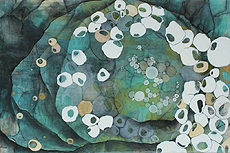Patterns dominate at new exhibit in Fermilab Art Gallery
 |
| Jen Evans' painting "Safe" is currently on display in the Fermilab Art Gallery. |
The pieces in the latest exhibit in the Fermilab Art Gallery, "Systems and Intuition," engage viewers through organic arrangements of repeated shapes, lines and colors inspired by nature and everyday objects.
The show features three Chicagoland artists — Fawn Clarke-Peterson, Jen Evans and Rita Grendze — who have worked alongside each other for several years.
The exhibit will be up until June 26. An artist reception will take place in the gallery on Friday, May 1, from 5-7 p.m. A gallery talk by the artists will take place on Wednesday, May 6, from 11:30 a.m.-12:30 p.m.
Rita Grendze works with a range of materials, exploring their physicality. Her small installations and three-dimensional drawings, as she calls them, note the passage of time, reflect history and tell new narratives, which can be seen in patterns: the frays of yarn, the rumpled pages in a book, the grids formed by steel grates.
Clarke-Peterson likewise allows the very material of the clay to guide her in creating her wall-hung sculptures. Inspired by nature's imperfect patterns, Clarke-Peterson references the "flawed regularity" of natural systems, she said.
The paintings of Jen Evans are made of forms, fields and swirls of color at once chaotic and simple. Visual inspiration for her paintings come from "the likes of sidewalk cracks, river bubbles and accidental compositions found in laundry piles and within door frames," as she notes in an artist statement.
The three artists have held leadership roles at Water Street Studios in Batavia, which has another connection with Fermilab: the Science&Art@School initiative. Evans and Grendze in particular helped facilitate the students' work, which was recently displayed both at Fermilab and at Water Street Studios.
"The act of art making is finding a way to communicate a solution to a problem," Grendze said in an artist statement. "Intuition and logical systems are the two main means by which problems are solved. They are alternate sides of a single coin."
|